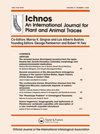Trace fossils on megafaunal bone remains from Quaternary natural tank deposits of Brazil: A case study in João Cativo Paleontological site, Megafauna Valley, Brazil
IF 2
4区 地球科学
Q4 PALEONTOLOGY
Ichnos-An International Journal for Plant and Animal Traces
Pub Date : 2023-01-02
DOI:10.1080/10420940.2023.2204232
引用次数: 1
Abstract
Abstract Northeastern Brazilian natural tank deposits stand out among the sedimentary deposits bearing megafauna remains in South America. João Cativo Paleontological Site (JCPS, Itapipoca, Ceará State, Brazil) is included in the Megafauna Valley and is one of the main sources of paleoecological data in that area. This study reveals trace fossils detected on Quaternary megafauna remains recovered from JCPS, allowing interpretation of paleosynecological interactions among the Quaternary megafauna taxa of the Brazilian Intertropical Region (RIB) and associated taxa. Only four of the 951 fossil specimens (cranial, post-cranial, osteoderms, and teeth) collected in the 1960s had biogenic signatures related to predation/scavenging and pre-historic human handling. Scratches on two rib fragments and a metapodial of Eremotherium laurillardi are attributed to the ichnospecies Machichnus fatimae and suggest a feeding interaction between a canid (probably Protocyon troglodytes) and the carcass of E. laurillardi. The anthropic mark corresponds to incisions made by a lithic weapon in the femur of a Palaeolama major, likely with the intent of slicing and sawing the carcass into smaller pieces.巴西第四纪天然水池沉积物中巨型动物骨骸上的痕迹化石:巴西巨型动物谷jo o Cativo古生物遗址的案例研究
巴西东北部天然油罐矿床在南美洲巨型动物遗骸沉积矿床中脱颖而出。jo o Cativo古生物遗址(JCPS, Itapipoca, cerar州,巴西)被列入巨型动物谷,是该地区古生态数据的主要来源之一。本研究揭示了在JCPS中发现的第四纪巨型动物遗骸上发现的痕迹化石,从而解释了巴西热带地区(RIB)第四纪巨型动物类群及其相关类群之间的古协同作用。在20世纪60年代收集的951个化石标本(颅骨、颅骨后、骨皮和牙齿)中,只有4个具有与捕食/食腐和史前人类处理有关的生物特征。月牙龙(Eremotherium laurillardi)的两根肋骨碎片和一根后跖骨上的划痕被认为是由鱼科动物Machichnus fatimae留下的,表明一种犬科动物(可能是类人猿)与月牙龙(e.laurillardi)的尸体发生了摄食互动。这一人为痕迹对应于石器武器在大古兽的股骨上留下的切口,很可能是为了把尸体切成小块。
本文章由计算机程序翻译,如有差异,请以英文原文为准。
求助全文
约1分钟内获得全文
求助全文
来源期刊
CiteScore
2.50
自引率
12.50%
发文量
0
审稿时长
>12 weeks
期刊介绍:
The foremost aim of Ichnos is to promote excellence in ichnologic research. Primary emphases center upon the ethologic and ecologic significance of tracemaking organisms; organism-substrate interrelationships; and the role of biogenic processes in environmental reconstruction, sediment dynamics, sequence or event stratigraphy, biogeochemistry, and sedimentary diagenesis. Each contribution rests upon a firm taxonomic foundation, although papers dealing solely with systematics and nomenclature may have less priority than those dealing with conceptual and interpretive aspects of ichnology. Contributions from biologists and geologists are equally welcome.
The format for Ichnos is designed to accommodate several types of manuscripts, including Research Articles (comprehensive articles dealing with original, fundamental research in ichnology), and Short Communications (short, succinct papers treating certain aspects of the history of ichnology, book reviews, news and notes, or invited comments dealing with current or contentious issues). The large page size and two-column format lend flexibility to the design of tables and illustrations. Thorough but timely reviews and rapid publication of manuscripts are integral parts of the process.

 求助内容:
求助内容: 应助结果提醒方式:
应助结果提醒方式:


